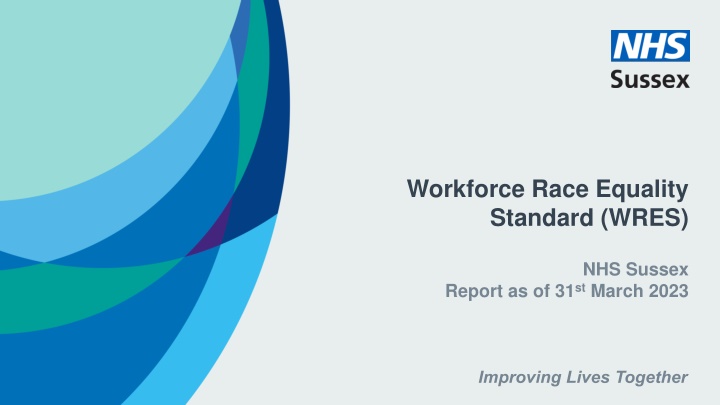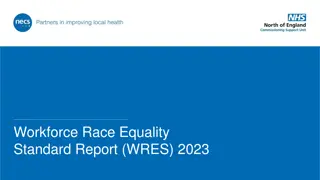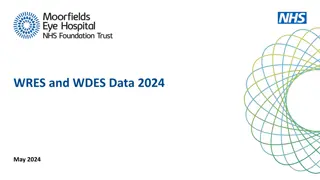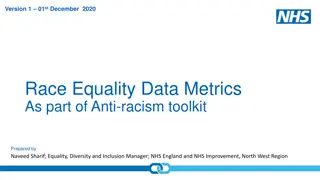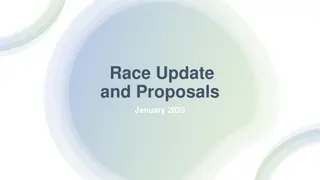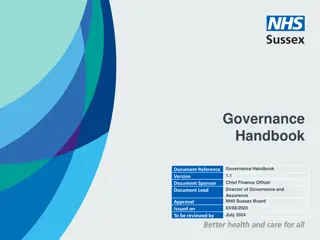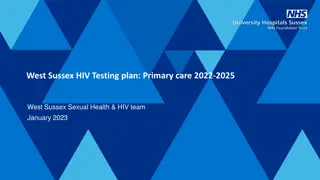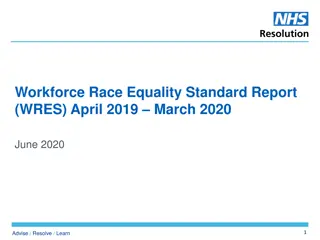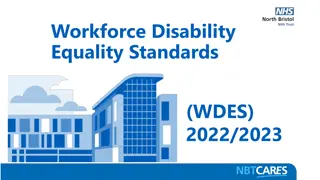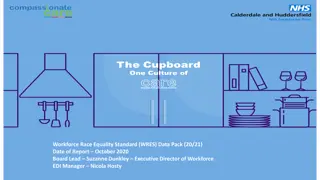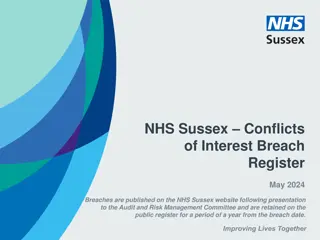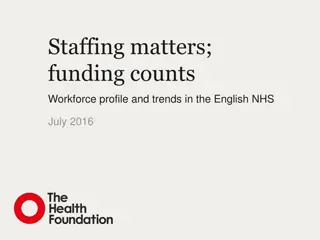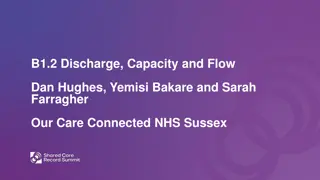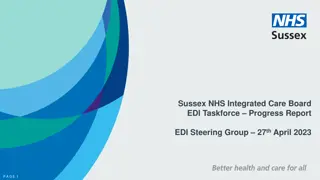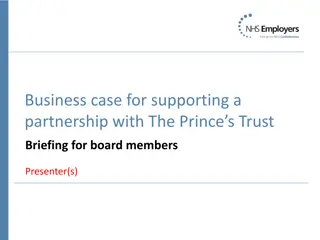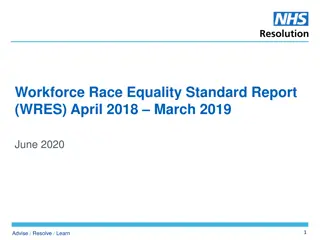NHS Sussex Workforce Race Equality Standard (WRES) Report 2023
NHS Sussex is committed to promoting equality and diversity within its workforce, as reflected in the latest Workforce Race Equality Standard report for 2023. Despite facing challenges such as significant organizational changes, limited recruitment, and internal restructuring, the report indicates sustained progress with a notable improvement in the access of ethnically diverse staff to training opportunities. The organization is proactively addressing areas needing further action and has established a comprehensive plan to enhance workforce equality, diversity, and inclusion.
Download Presentation

Please find below an Image/Link to download the presentation.
The content on the website is provided AS IS for your information and personal use only. It may not be sold, licensed, or shared on other websites without obtaining consent from the author.If you encounter any issues during the download, it is possible that the publisher has removed the file from their server.
You are allowed to download the files provided on this website for personal or commercial use, subject to the condition that they are used lawfully. All files are the property of their respective owners.
The content on the website is provided AS IS for your information and personal use only. It may not be sold, licensed, or shared on other websites without obtaining consent from the author.
E N D
Presentation Transcript
Workforce Race Equality Standard (WRES) NHS Sussex Report as of 31stMarch 2023
Introduction NHS Sussex is committed to promoting equality and diversity and tackling inequalities experienced by our ethnically diverse workforce, so we are pleased to share our WRES report for the period ending 31st March 2023. The Steering Group is also overseeing delivery of our EDI Taskforce Recommendations and our target of achieving Level 4 in the Global Diversity, Equality and Inclusion Benchmark. PowerPoint Presentation (ics.nhs.uk) This year ICBs were not required by NHS England to undertake WRES reporting given the transitional status of the organisations nationally. However, we have undertaken the work as part of our ongoing commitment to race equality for our people and to ensure that we continue to make progress and/or understand the areas in which we need to take further action. Over the past year the organisation has established itself as a new Integrated Care Board (ICB) and as such is undergoing transformational change to meet its new statutory requirements and achieve the vision set out in the Sussex Integrated Care Strategy for our populations. The results have been discussed with our Ethnically Diverse Staff Network, who have continued to grow and lead exciting programmes including our new system wide Black History Month programme for 2023. This change programme includes an organisational restructure of our functions and teams aligned to a new Targeted Operating Model (TOM). The TOM is being informed by an Equality and Health Inequality Impact Assessment that includes data from our WRES reports and considers, pro-actively, the actions we can take to promote race equality and mitigate any negative impacts. The report shows that overall, we have continued to sustain our progress despite no statistically significant change across most indicators. Whilst we recognise that this means no substantive improvement, we are mindful of the results during a time of significant change, limited recruitment and internal restructure. We are however particularly pleased that our data this year shows that the relative likelihood of ethnically diverse staff accessing non-mandatory training and continuous professional development (CPD) compared to white staff is now 1.1 (an improvement on the 2022 result of 1.21). The organisation has also established an Equality, Diversity and Inclusion Steering Group, co-chaired by our Chief People Officer and the Chair of our EDI Taskforce with membership including our Staff Network Chairs. This group has agreed our 2023/24 Workforce Equality, Diversity and Inclusion (EDI) Plan PowerPoint Presentation (ics.nhs.uk) which sets out objectives and improvement priorities and reports progress six monthly to our Executive Committee. We look forward to continuing our journey this year in partnership with our staff and stakeholders.
Key Headlines and High Impact Actions Headline Results High Impact Actions and Progress The 2021 census data shows 9.0% of Sussex residents identify as ethnically diverse compared to 9.3% of NHS Sussex staff, indicating that NHS Sussex is broadly reflective of the population it serves overall. The percentage of staff with unknown ethnicity has decreased and is now 8.1% compared to 9.7% in 2022 Overall, there is no statistically significant change in our ethnic diversity. Our detailed workforce diversity report (available here: Culture, values and ethics - NHS Sussex) shows that some Directorates and Teams are not representative of the population. The associated action plan agreed by our Executive Committee sets out how we will address this. These actions include undertaking a diversity recording campaign to continue to decrease the numbers of staff not sharing their ethnicity information on the NHS Employment Support Record (ESR). We have developed a detailed Equality & Health Inequality Impact Assessment (EHIA) to support the NHS Sussex Targeted Operating Model (TOM) process to ensure we are proactive in undertaking actions that maintain and improve our workforce diversity. Our March 2023 data suggests that the relative likelihood of White staff being appointed from shortlisting compared to ethnically diverse staff has marginally worsened and now stands at 1.72 (compared to 1.67 in 2022), although the change is not considered statistically significant. Our Inclusive Recruitment Policy, Procedure and Training was launched in January 2023 (Recruitment-Policy-2023.pdf (ics.nhs.uk), and 14 Diversity Champions are in place to support inclusive recruitment by being part of recruitment campaigns end to end. We will therefore continue to monitor this this indicator through our EDI Steering Group and Ethnically Diverse Staff Network and collate feedback from our Diversity Champions for continuous improvement of process and outcomes. The number of ethnically diverse staff entering the NHS Sussex formal disciplinary process remains at zero, which is consistent with previous years and compares favourably to the national average of 1.14. We will continue to focus on supporting staff and managers to resolve issues informally and by mutual agreement with the support of the Ethnically Diverse Staff Network and/or Equality, Diversity and Inclusion Team where appropriate. Our staff survey data for March 2023 shows that the Relative likelihood of ethnically diverse staff accessing non-mandatory training and continuous professional development (CPD) compared to White staff is now 1.1 (an improvement on the 2022 result of 1.21). Despite this, a significantly higher percentage of white staff (58.2%) reported that they believed that the organisation acts fairly regarding career progression in comparison to 38.4% of ethnically diverse staff. This compares to 56.2% and 30.6% respectively for 2022, so whilst there has been some positive increase, this is still an adverse outcome for ethnically diverse staff and continues to be a priority focus. We will continue to ensure that our ethnically diverse staff have access to our range of learning and development opportunities through targeted communications and outreach. We will also develop bespoke opportunities as identified through the Staff Network. We will continue to offer targeted access to our ASPIRE and ASPIRING leadership development programmes which have enabled participants to progress in their careers with 50% of cohort one achieving a promotion. The Head of Organisational Development and the Head of Equality, Diversity and Inclusion attended the Ethnically Diverse Network on 7th September 2023 to consult on other opportunities the Network would find helpful, and these are now being developed into achievable actions. There has been positive progress regarding a lower percentage of ethnically diverse staff experiencing bullying, harassment and discrimination from patients but an increase in this experience in relation to staff and Mangers. Our new FTSU Guardian will prioritise building relationships with our Ethnically Diverse Staff Network to support them to raise concerns early about harassment, bullying or abuse from other staff and Managers. Any patterns or trends will be shared anonymously for further actions to be considered.
Overall Workforce Diversity in NHS Sussex NHS Sussex has always used workforce diversity data on race to enable us to understand the ethnic diversity of our organisation and consider where action may be required; for example, in relation to equal progression. Date No. of White staff % of White staff No of Ethnically Diverse Staff % Ethnically Diverse Staff No. of unknown ethnicity % unknown ethnicity Comparing this to our local ethnically diverse population can also help us understand the extent to which we are representative of our populations. 31 March 2019 666 82% 85 10.5% 61 7.5% The 2021 census data shows 9.0% of Sussex residents identify as ethnically diverse compared to 9.3% of NHS Sussex staff, indicating that NHS Sussex is broadly reflective of the population it serves overall. 31 March 2020 666 82.5% 89 11% 52 6.4% 31 March 2021 707 82% 96 11% 63 7.4% In the past 12 months the overall number of ethnically diverse staff has decreased by less than 5, with a marginal impact on overall percentages which are not statistically significant. 31 March 2022 759 80.7% 91 9.7% 90 9.6% 31 March 2023 781 82.6% 77 8.1% 88 9.3% The percentage of staff with unknown ethnicity has decreased and is now 8.1% compared to 9.7% in 2022. A diversity recording campaign is currently underway to address this further.
Indicator 1(A): Percentage of staff in each of the AfC Bands 1-9 or Medical and Dental subgroups and VSM (including executive Board members) compared with the percentage of staff in the overall workforce NON CLINICAL White Staff Ethnically Diverse Staff Unknown ethnicity The percentage of non-clinical staff has generally stayed the same for ethnically diverse staff apart from Pay Bands 8C to9 and VSM where the percentage has dropped to 8% from 12%. Sussex CCGs % Headcount % Headcount % Headcount 2021 2022 2023 2021 2022 2023 2021 2022 2023 2021 2022 2023 2021 2022 2023 2021 2022 2023 Pay Bands under 1 and 1 to 4 92% 93 4% 4 4% 4 90% 92% 102 105 8% 4% 9 5 2% 4% 2 4 Pay Bands 5 to 7 Pay Bands 8a to 8b Pay Bands 8c to 9; VSM 82% 81% 82% 184 8% 17 11% 10% 8% 24 213 222 8% 10% 22 27 27 20 83% 77% 80% 128 5% 8 12% 12% 8% 19 97 120 11% 11% 14 17 15 12 79 % 74% 57 106 12% 12% 8% 9 14% 11 84% 103 15 10 9% 8% 12 10
Indicator 1(B): Percentage of staff in each of the AfC Bands 1-9 or Medical and Dental subgroups and VSM (including executive Board members) compared with the percentage of staff in the overall workforce - CLINICAL There has been change in the headcount of ethnically diverse staff in clinical bandings, some groups have seen growth, such as Bands 8d to VSM while others, (Bands 1 to 4 for example) have seen a reduction. White Staff Ethnically Diverse Staff Unknown Ethnicity % 202 2 Headcount 202 1 % 202 2 Headcount 202 1 % 202 2 Headcount 202 1 202 1 202 3 202 2 202 3 202 1 202 3 202 2 202 3 202 1 202 3 202 2 202 3 It should be noted that the percentages are expressed as a percentage of the headcount in the banding groups and not the overall workforce. As a result of the relatively low headcount in the clinical bandings small reductions or increases can create what appears to be significant variance to the year-on-year results but this may not actually be the case. Pay Band s under 1 and 1 to 4 100% 80% 100% 3 0% 0 0% 0 4 1 20% 0% 1 0 0% 0% 0 0 Pay Band s 5 to 7 85.7 % 86% 87% 132 6% 9 8% 12 132 137 7.1% 6% 11 9 7.1% 7% 11 11 Indicator 1(C): Percentage and headcount of clinical (medical) ethnically diverse staff at each pay band compared to white staff (as at 31.03.23) Pay Band s 8a to 8b 79.5 % 11.5 % 80% 79% 69 10% 9 9% 8 62 65 11% 9 9 9% 10% 7 8 Pay Band s 8c to 9 to VSM Ethnically diverse Staff White Staff Unknown ethnicity 52.33 % 33.33 % 14.33 % 70% 75% 7 0% 0 30% 3 15 11 10% 2 7 15% 3 3 % Headcount % Headcount % Headcount 202 1 202 2 202 3 202 1 202 2 202 3 202 1 202 2 202 1 202 2 202 3 202 1 202 2 202 1 202 2 202 3 2023 2023 14.66 % 33.33 % 61 % 60% 52% 34 31 14 12% 13% 7 27% 27% 15 Other 7 4 14 9
Indicator 2: Relative likelihood of White applicants being appointed from shortlisting across all posts compared to ethnically diverse applicants Our March 2023 data suggests that the relative likelihood of White staff being appointed from shortlisting compared to ethnically diverse staff has marginally worsened and now stands at 1.72 (i.e., White members of staff are more than one and a half times as likely to be appointed from shortlisting). Organisation 2020 2021 2022 2023 Sussex NHS ICB 2.28 2.02 1.67 1.72 This change is not considered statistically significant. However, this is still slightly worse that the 1.61 national average and 1.48 average for NHS Trusts in the South East so further improvement remains an ongoing priority.
Indicators Three and Four Indicator 3: Relative likelihood of ethnically diverse staff entering the formal disciplinary process compared to White staff (as measured by entry into a formal disciplinary investigation) The number of ethnically diverse staff entering the NHS Sussex formal disciplinary process remains at zero, which is consistent with previous years and compares favourably to the national average of 1.14. Indicator 4: Relative likelihood of ethnically diverse staff accessing non-mandatory training and continuous professional development (CPD) compared to White staff Our March 2022 data found that the relative likelihood of white staff accessing non-mandatory training and CPD compared to ethnically diverse staff was at a ratio of 1.21 However, our data for March 2023 show that this has significantly improved to a ratio of 1:1 which is a very positive improvement representing equity of access.
Indicators Five to Eight Indicator 5: Percentage of staff experiencing harassment, bullying or abuse from patients, relatives or the public in last 12 months A higher percentage of ethnically diverse staff 91.7% reported that they had not experienced harassment bullying or abuse from patients or relatives of the public in the last year in comparison to 88.1% white staff. This compares to 88.4% and 84.9% respectively for 2022 so a positive progression. This is a favourable result for our ethnically diverse staff. Indicator 6: Percentage of staff experiencing harassment, bullying or abuse from staff in last 12 months A lower percentage of ethnically diverse staff 86.3% reported that they had not experienced harassment, bullying or abuse from staff in the last 12 months in comparison to 94.1% of white staff.This compares to 89.7% and 85.9% respectively for 2022. This is an adverse outcome for our ethnically diverse staff. Indicator 7: Percentage of staff believing that trust provides equal opportunities for career progression or promotion A significantly higher percentage of white staff (58.2%) reported that they believed that the organisation acts fairly in regards to career progression in comparison to 38.4% of ethnically diverse staff. This compares to 56.2% and 30.6% respectively for 2022, so whilst there has been some positive increase, this is still an adverse outcome for ethnically diverse staff and continues to be a priority focus. Indicator 8: Percentage of staff personally experiencing discrimination at work from a manager/team leader or other colleagues A lower percentage of ethnically diverse staff 86.3% reported that they had not experienced discrimination at work from a manager/team leader and other colleagues in comparison to 94.1% of white staff. This compares to 87.5% and 95% respectively for 2022. This is an adverse outcome for ethnically diverse staff and a priority focus.
Indicator 9: Percentage of Voting Board Members by Ethnicity NHS Sussex Board Diversity Profile Organisational Status % Ethnically diverse Year % White % Unknown 31 March 2020 62.8% 9.3% 27.9% CCGs 31 March 2021 63.6% 13.6% 22.7% CCGs CCGs 31 March 2022 63.4% 17.11% 19.5% ICB 31 March 2023 50.0% 33.3% 16.7% The new NHS Sussex Board was established in July 2022 and its overall composition is very different and in line with the national requirements of ICBs. This includes Board members that are representatives of our system partners and therefore not NHS employees whose data cannot be collected for this Indicator. This makes direct comparisons to the data for the previous year's difficult however 33.3% of the NHS Board Members (which includes both Executive and Non-Executive Directors) were ethnically diverse meaning as at 31st March 2023 meaning there is strong representation of both the ethnically diverse workforce and population.
Next Steps Our EDI Steering Group will continue to oversee our WRES improvement programme as part of our NHS Sussex Workforce EDI Improvement Plan, which brings together all workforce equality improvement activity and is available here: https://www.sussex.ics.nhs.uk/nhs-sussex/our-values/equality- diversity-and-inclusion/ For further information please contact or alternative formats, please contact Our Ethnically Diverse Staff Network (Staff networks - Sussex Health and Care (ics.nhs.uk)) will continue to co-lead this work alongside challenging the organisation where further work or progress is required. Nicky Cambridge, Head of Equality, Diversity and Inclusion We will report progress through the EDI Steering Group and embed the high impact actions described in this report into our wider workforce improvement plans to ensure that it is continuously refreshed and reflective of our current WRES indicator position. nicky.cambridge@nhs.net Finally, we will ensure that our Targeted Operating Model Change Programme is informed by pro-active thinking and action using WRES and other data. The EHIA capturing this work will be reviewed monthly by the EDI Steering Group.
